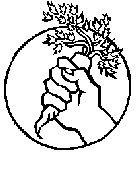
| Contents | Start | Previous | Next |
We carried water, fruit, and, of course, carrots, and we raced straight up the side of a steep, rocky cliff. Our path wove just north of the crest of the ridge, so we would be our of the Wackenhuts' sight down in the valley by the main gate. The flowers and wildlife up among the rocks were beautiful and brightly colored, and that inspired moving conversations about the contrast between this beauty and the nuclear destruction occurring right at the end of this mountain range. As we walked, we would stop and place stones in the shape of peace symbols. It was so beautiful we wanted to forget that our presence on this ridge was a protest against nuclear testing and just enjoy our hiking trip, but we were rudely reminded when a surveillance helicopter flew overhead. We quickly jumped down onto a ledge behind some high rocks. The Wackenhuts in the helicopter didn't seem to see us, but we weren't too sure. We decided to head for the valley floor and get as close to Mercury as possible before we were caught. When we got to the valley floor, we found a marker for an old ground zero capped in clay. We put it in the center of a giant peace symbol made of rocks. As we made the long hike across the desert to Mercury, it became clear we had not yet been spotted.
During the afternoon, we happened upon a building that seemed like it was supposed to represent a house just outside the blast area, and several hours later, we came to a white water tank sitting at the edge of the town of Mercury. Not far away, we could see two guys in a pickup who looked like they were hiding behind the tank and drinking beers. We were trying to decide what we should do when we got to Mercury when several white pickup trucks and vans sped over to where we were. Men with machine guns jumped out, surrounded us, and ordered us to lie on our stomachs. Then they frisked us, handcuffed us, and put us in one of the vans.
As we were being transported out of Mercury, we passed an amazing array of "Star Wars" weapons. We commented to each other about them, but were told by the guards to look straight ahead and not look at or talk about these weapons. We all stared at the weapons anyway, and talked about how their sinister appearance was a clear reflection of the mentality of those who thought that building nuclear bombs was a good idea. Just like prisoners of war, we finally were ordered out of the van and marched at gunpoint into the "cage," a large fenced-in area of the desert divided into men's and women's sections near the main gate. It was cold and getting dark, and our food had been confiscated. Once imprisoned and without food, our conversation naturally turned to protests that involved fasting.
* * *
The Veterans Fast For Life came to mind. This was one of Food Not Bombs' most empowering events that we ever had the privilege to attend. Veterans all over the country planned to fist and hold rallies. In Boston, they made an encampment on the Boston Common with tents and banners, and they were highly visible and outspoken. With our biggest banner, we went to the Common to support their protest against the secret U.S. wars in Central America. However, this time we didn't bring our food, because we wanted to honor the veterans who were fasting. Because we were well known by the people living on the street around the Common by this time, they would come up to us and ask where our food was. We told them about the fast and they were shocked. They had never seen Food Not Bombs tables without food.
* * *
Back in Nevada, as we sat in the cage, our supporters outside the main gate were busy. We could see a crowd that had gathered at the main gate earlier in the day; more blockade actions across the road had resulted in many arrests and, consequently, more people in the cage. Food Not Bombs had been there feeding the crowd all day. Now that the day was coming to an end, the supporters who remained were drumming and dancing in celebration of another successful day of protest. Suddenly, inside the cage, oranges and apples started falling from the sky.

| Contents | Start | Previous | Next |